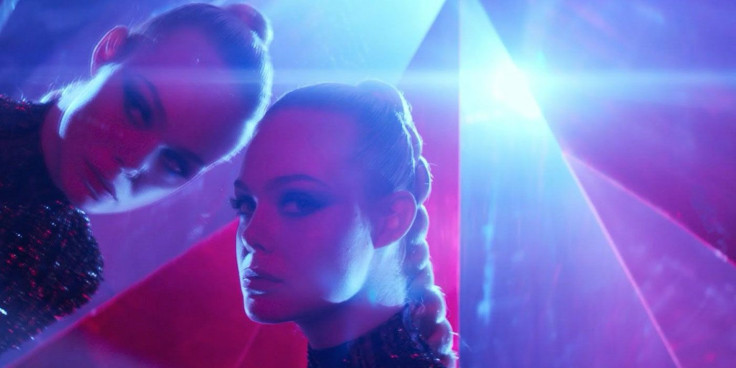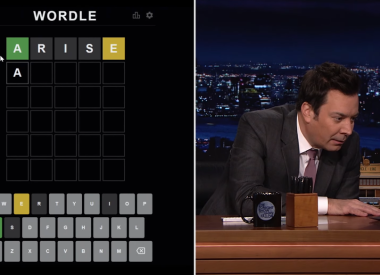In her first runway show, Jesse (Elle Fanning) sees no audience. The world has fallen away, even the flashbulbs are dialed back to abstract flashes. Emerging from a blue Zardoz diamond into a black space, Jesse can only see herself refracted and reflected back at her. Then, across the room, an inverted, neon Triforce absorbs her gaze. It is not the Triforce of Wisdom, Power or Courage. She kisses the reflections of herself in the diamond that surrounds her, while, across the runway burns the Triforce of Self-Regard, her environment come to reflect her interior at last.
The scene is one of the few symbolic fugues in The Neon Demon, a film too literal to be as symbol-laden and surreal as it clearly aims to be, but subsequently too abstract to be characterful.
Jesse arrives in town and gets everything she wants without effort. Her first photo shoot (a gorgeous, crime scene tableau) gets her into Roberta Hoffman’s (Christina Hendricks) top agency, her plate already heaped high with praise. Though her first professional photo shoot is loaded with sexual menace, the results are everything she wanted. Everywhere people fall before her beauty.
The rest of the industry (and the world) is either jealous or exploitative of Jesse’s vibrancy (“like the sun” as a literally vampiric model tells her). There are both crude and “sophisticated” ways this comes out, from Keanu Reeves’ (his character’s name is Hank, but his every onscreen moment feels like an “isn’t it wild to watch Keanu be a scuzz!” stunt) knife fellatio sexual assault to the utter menace and contempt the fashion world’s leading photographer radiates. Her fellow models — jealous of the industry bigwigs revolving around her — want her gone. Her friends just want to fuck her.
With Jesse’s essential passivity and the rest of the characters’ essential malice, The Neon Demon isn’t exactly drawing us into anyone’s world. That the film’s end collapses completely into symbolism, reducing Jesse to no more than energy feeding a rapacious monster industry, feels less like a crescendo and more like necessity. The Neon Demon can’t satisfactorily tell Jesse’s story with Jesse, because Jesse is barely a character. Time for more visual nods to The Shining! (Only this time with a vagina instead of elevator doors.)
The Neon Demon interrogates “beauty” to the fullest, but is unlikely to dazzle you with its insights. Beauty is tied to youth. Beauty is power (even if that power is circumscribed by the patriarchy).
But like Jesse, beauty is passive as a central element of The Neon Demon. Aesthetic beauty has always been a part of art, but a limited one. In ugliness, passion, violence, awe and anger there is the possibility of reaction. By comparison aesthetic beauty is inert. What can you do other than appreciate it? With beauty The Neon Demon has picked an uninspiring symbolic field, with plenty to say but nothing to dialogue, like playing ping pong with a brick wall. Beauty may be everything, as a high-profile designer insists in Demon, but that doesn’t speak to what it actually does.
But really, The Neon Demon cares more about its exploitation schlockiness and psychedelia than any interrogation of beauty. That hypnotic, surreal imagery in the trailer, is its real aim. A body floats in a red strobe light. Fingers push through a solid wall. A mountain lion roars as it leaps up on the bed of a sleazy motel. Many feel as without context in the movie as they do in the trailer, while other moments are built far too laboriously, stringing us along with dull characters just to explain an outlandish shot or two.
The end makes it especially clear that The Neon Demon was just going to do whatever the hell it wanted anyway (next sentence is vague, but spoiler-y). Jesse is left behind entirely, The Neon Demon as much as admitting that it doesn’t really care about the story it was telling either.
But it does care about the exploitation. The Neon Demon has necrophilia, cannibalism and scenarios of sexual menace that would fit perfectly into a 70s grindhouse film (the one actual rape is off-screen and effectively unsettling). It may reek of provocation, but it’s at least honest. Director Nicolas Winding Refn is far less artful at weaving in his influences seamlessly like Quentin Tarantino, so it’s obvious The Neon Demon is more alluding to cinema’s history of gruesome sex than throwing the middle finger at a generation of filmgoers likely to tear apart the film’s sexual politics. While this teardown at Jezebel is right in most particulars, I found The Neon Demon consistently more eye-rolly than offensive. Your mileage may vary.
The Neon Demon thwarts itself with ambitions. The crazed, luscious surrealism is held back by a desire to tell a straightforward story. The story is held back by retreats into surreal symbolism. So we are left with broken half-things, especially Jesse (though Fanning sells what little she’s given), the protagonist with nothing to do but strut blindly to her fate.
Refn has called The Neon Demon a “horror movie.” It is not. It is instead a half-baked psychological thriller larded with horror-like indulgences, with violent gestures that barely make a blip amongst all the glittery, vague menace.


















